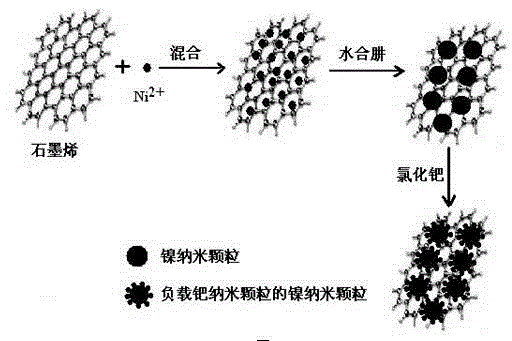Trace palladium nanoparticle for electrochemical catalysis ethanol oxidation, preparation method and application of trace palladium nanoparticle
A technology for palladium nanoparticles and ethanol oxidation, which can be applied in chemical instruments and methods, physical/chemical process catalysts, metal/metal oxide/metal hydroxide catalysts, etc., and can solve problems such as reducing the amount of palladium
- Summary
- Abstract
- Description
- Claims
- Application Information
AI Technical Summary
Problems solved by technology
Method used
Image
Examples
Embodiment 1
[0019] (1) 40 mg nickel chloride (NiCl 2 ·6H 2 O) Dissolved in 20 mL of ethylene glycol / water mixed solvent with a volume ratio of 1:1, then added 200 mg of graphene powder, and the mixture was o After ultrasonic dispersion in a water bath of C for 10 minutes, slowly add dilute NaOH solution to the mixture to adjust the pH of the mixture to 8-9; then continue to ultrasonically disperse the mixture for 1 hour to form nickel ions uniformly dispersed in the graphene Dispersion on the surface.
[0020] (2) Heat the above dispersion system in a water bath to 40 o C. Slowly add 6 mL of 5% hydrazine hydrate aqueous solution under continuous stirring. After the addition, continue to stir for 3 hours, filter while hot, wash with water until neutral, and then wash with ethanol twice, and the obtained black solid Immediately blow dry with nitrogen, then place in a vacuum oven, and dry at room temperature for 24 hours to obtain graphene-supported nickel nanoparticles.
[0021] (3)...
Embodiment 2
[0025] (1) 80 mg nickel chloride (NiCl 2 ·6H 2 O) Dissolved in 40 mL of ethylene glycol / water mixed solvent with a volume ratio of 1:1, then added 500 mg of graphene powder, and the mixture was o After ultrasonic dispersion in a water bath of C for 10 minutes, slowly add dilute NaOH solution to the mixture to adjust the pH of the mixture to 8-9; then continue to ultrasonically disperse the mixture for 1 hour to form nickel ions uniformly dispersed in the graphene Dispersion on the surface.
[0026] (2) Heat the above dispersion system in a water bath to 40 o C. Slowly add 11 mL of 5% hydrazine hydrate aqueous solution under continuous stirring. After the addition, continue to stir for 4 hours, filter while hot, wash with water until neutral, and then wash with ethanol twice. The obtained black solid Immediately blow dry with nitrogen, then place in a vacuum oven, and dry at room temperature for 24 hours to obtain graphene-supported nickel nanoparticles.
[0027] (3) Mi...
Embodiment 3
[0031] (1) Add 120 mg nickel chloride (NiCl 2 ·6H 2 O) Dissolved in 60 mL of ethylene glycol / water mixed solvent with a volume ratio of 1:1, then added 800 mg of graphene powder, and the mixture was o After ultrasonic dispersion in a water bath of C for 10 minutes, slowly add dilute NaOH solution to the mixture to adjust the pH of the mixture to 8-9; then continue to ultrasonically disperse the mixture for 1 hour to form nickel ions uniformly dispersed in the graphene Dispersion on the surface.
[0032] (2) Heat the above dispersion system in a water bath to 40 o C. Slowly add 16 mL of 5% hydrazine hydrate aqueous solution under continuous stirring. After the addition, continue to stir for 6 hours, filter while hot, wash with water until neutral, and then wash with ethanol twice, the obtained black solid Immediately blow dry with nitrogen, then place in a vacuum oven, and dry at room temperature for 24 hours to obtain graphene-supported nickel nanoparticles.
[0033] (...
PUM
 Login to View More
Login to View More Abstract
Description
Claims
Application Information
 Login to View More
Login to View More - R&D
- Intellectual Property
- Life Sciences
- Materials
- Tech Scout
- Unparalleled Data Quality
- Higher Quality Content
- 60% Fewer Hallucinations
Browse by: Latest US Patents, China's latest patents, Technical Efficacy Thesaurus, Application Domain, Technology Topic, Popular Technical Reports.
© 2025 PatSnap. All rights reserved.Legal|Privacy policy|Modern Slavery Act Transparency Statement|Sitemap|About US| Contact US: help@patsnap.com


